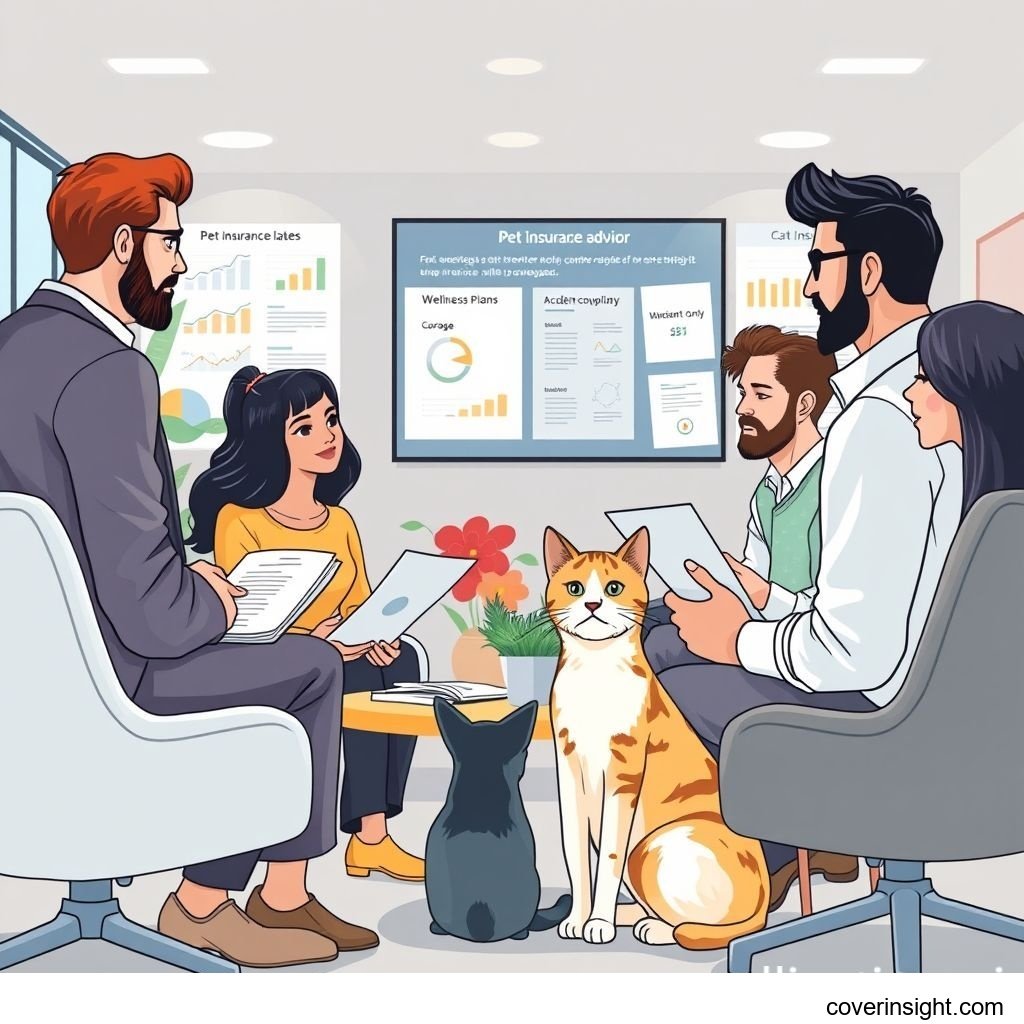Introduction
As we head into 2025, the landscape of pet care in the US continues to evolve, with more pet parents recognizing the vital role of financial planning for their beloved feline companions. Cat insurance, particularly policies that include wellness coverage, is no longer just a luxury; it’s becoming an essential tool for managing unexpected veterinary costs and ensuring your cat receives the best possible care throughout their life. From routine check-ups to sudden emergencies, understanding the nuances between accident-only and comprehensive plans can provide invaluable peace of mind and protect your wallet from the financial bombshells of unforeseen health issues.
Coverage Details
Choosing the right pet insurance plan for your cat boils down to understanding what each policy actually covers, and perhaps more importantly, what it doesn't. This decision often hinges on balancing cost, risk tolerance, and your cat’s specific needs.
What’s Included
Accident-Only Pet Insurance This type of policy is the most basic and typically the most affordable. As the name suggests, it provides coverage solely for injuries and emergencies resulting from accidents. Think of scenarios like a cat falling from a height and breaking a bone, ingesting a toxic substance, getting hit by a car, or sustaining injuries from a fight with another animal. These plans are designed to help with the sudden, high-cost bills associated with emergency treatments, X-rays, surgeries, and medications directly related to an accident. For many pet parents who are primarily concerned about catastrophic, unexpected events that could truly "break the bank," an accident-only policy offers a crucial safety net.
Comprehensive Pet Insurance Taking it a significant step further, comprehensive plans offer a much broader scope of protection. They include everything covered by accident-only policies but also extend to illnesses. This means conditions like cancer, diabetes, arthritis, ear infections, digestive issues, and allergies are typically covered. For a feline friend, this could mean covering diagnostics for mysterious vomiting, ongoing treatment for chronic kidney disease, or chemotherapy for a newly diagnosed tumor.
Many comprehensive plans also offer an optional add-on for wellness coverage. This is where the proactive care comes in. Wellness riders typically cover routine preventative care, such as annual veterinary exams, vaccinations, flea and tick prevention, deworming, and sometimes even dental cleanings. While these are predictable expenses, having them covered by insurance can help budget for essential preventative health, ensuring your cat stays in tip-top shape and potentially avoiding more serious, costly issues down the line. It's truly about covering all your bases, from the yearly check-up to the most dire emergency.
Common Exclusions
While pet insurance offers a significant financial cushion, it’s vital to be aware of what's generally not covered. The most widespread exclusion across almost all pet insurance policies is pre-existing conditions. This refers to any illness or injury your cat had before your policy started, or during its waiting period. For instance, if your cat was diagnosed with diabetes before you bought insurance, treatments for that condition will likely not be covered. Some policies may distinguish between curable and incurable pre-existing conditions, but this is less common.
Other common exclusions often include:
-
Elective procedures: Things like cosmetic surgery (e.g., declawing, ear cropping, tail docking – though less common for cats, these are generally not covered for any pet).
-
Grooming: Services such as nail trims, baths, or de-shedding treatments.
-
Breeding or pregnancy-related costs: If you plan to breed your cat, expenses related to pregnancy, birth, or nursing are typically not covered.
-
Experimental or investigational treatments: Any treatments not yet widely accepted in veterinary medicine.
-
Behavioral issues: While some advanced comprehensive plans might offer limited coverage for behavioral therapies, many policies exclude them entirely.
-
Supplements or prescription food: Unless prescribed by a vet to treat a covered condition and specifically included in your policy, these are often excluded.
Always read your policy’s fine print, including the "Insurance Resources Global" section, to understand specific exclusions and waiting periods, as these can vary significantly between providers.
Cost Analysis
Understanding the factors that influence pet insurance premiums and knowing how to save money can make a significant difference in your annual budget.
Price Factors
The cost of cat insurance, whether accident-only or comprehensive with wellness coverage, isn't a one-size-fits-all figure. Several key factors play a role in determining your monthly or annual premium:
-
Your Cat's Age: Younger cats are generally cheaper to insure because they're less prone to age-related illnesses. Premiums will typically increase as your cat gets older, reflecting the higher likelihood of veterinary visits.
-
Breed: While less impactful for cats than for some dog breeds, certain cat breeds (like Persians or Maine Coons) might be predisposed to specific genetic conditions, which can slightly influence premiums. Mixed-breed cats are often the most affordable to insure.
-
Location: Where you live in the US has a major impact. Veterinary costs vary significantly by state and even by ZIP code, particularly in metropolitan areas. For instance, premiums in a bustling city like New York or Los Angeles tend to be higher than in rural areas, directly reflecting the higher cost of veterinary care there. According to a recent analysis by a credible US industry body, veterinary service costs have seen a steady increase, with an average hike of 4-6% annually in many urban centers over the past five years.
-
Deductible: This is the amount you pay out-of-pocket before your insurance coverage kicks in. A higher deductible will result in a lower monthly premium, but you'll pay more upfront if your cat needs care.
-
Reimbursement Level: This is the percentage of the vet bill your insurance company will reimburse after your deductible is met (e.g., 70%, 80%, or 90%). A higher reimbursement level means a higher premium.
-
Annual Limit: Most policies have an annual maximum payout. Choosing a higher annual limit means a higher premium but offers more protection for catastrophic events.
-
Type of Plan: As expected, accident-only plans are considerably cheaper than comprehensive plans. Adding wellness coverage will further increase the premium.
Saving Tips
Even with varying costs, there are smart ways to make pet insurance more affordable without sacrificing essential coverage:
-
Choose a Higher Deductible: If you have an emergency fund for your cat and are comfortable paying more out-of-pocket initially, opting for a higher deductible can significantly lower your monthly premium.
-
Adjust Reimbursement Level and Annual Limit: Evaluate your financial comfort level. A slightly lower reimbursement percentage (e.g., 80% instead of 90%) or a reasonable annual limit can reduce costs.
-
Multi-Pet Discounts: Many insurers offer discounts if you enroll multiple pets. If you have more than one cat (or other pets), this can be a smart way to save.
-
Annual vs. Monthly Payments: Some providers offer a small discount if you pay your premium annually rather than monthly.
-
Preventative Care: While wellness plans cost extra, investing in preventative care can actually save you money in the long run by catching potential health issues early, before they become serious and expensive. A stitch in time saves nine, right?
-
Shop Around: Don’t settle for the first quote you get. Visit several insurance providers and compare their plans and prices on a site like "US Insurance Home". Policies can vary wildly in terms of cost and what they offer.
FAQs
How much does cat insurance with wellness coverage cost?
The cost can vary widely, but for a comprehensive cat insurance plan with wellness coverage, you might expect to pay anywhere from $35 to $70+ per month in 2025. Accident-only plans are generally much cheaper, often ranging from $15 to $30 per month. Remember, these are just averages, and actual costs depend heavily on your cat's specifics and your location. For example, a young, healthy tabby in rural Kansas will likely cost less to insure than an older, purebred cat in downtown Los Angeles.
What affects premiums?
As discussed, premiums are influenced by your cat's age, breed, and your geographic location (due to varying veterinary costs). Your chosen deductible, reimbursement percentage, and annual coverage limit also play a massive role. The more coverage you opt for, and the less you want to pay out-of-pocket, the higher your premium will be.
Is it mandatory?
No, pet insurance is not mandatory in the US. Unlike human health insurance, there's no legal requirement to have coverage for your pet. However, as one pet owner in Arizona sadly discovered when their cat, Mittens, swallowed a string, requiring emergency surgery that racked up a $4,000 bill, having insurance can be a financial lifesaver. Without it, they had to rely on a payment plan, putting a strain on their budget for months. Pet insurance is a choice, but one that many responsible pet parents find invaluable for managing unexpected veterinary expenses.
How to choose?
When choosing a plan, consider your budget, your cat's age and health status, and your own risk tolerance. If your cat is young and generally healthy, an accident-only plan might suffice for major emergencies. If you have an older cat, a breed prone to specific conditions, or simply want full protection, a comprehensive plan with or without wellness is likely a better fit. Always compare quotes, read policy details carefully, and check reviews. The National Association of Insurance Commissioners (NAIC) website offers valuable resources for understanding insurance types and consumer rights, and your State Insurance Departments can provide specific regulatory information.
Consequences of no coverage?
Without pet insurance, you are solely responsible for 100% of your cat’s veterinary bills. This means that if your cat suddenly develops a serious illness like kidney failure or is involved in an accident, you could face bills ranging from hundreds to tens of thousands of dollars. For many families, such unexpected costs can lead to difficult decisions about a pet's care, potentially forcing them to choose less effective treatments, delay care, or in extreme cases, even consider economic euthanasia – a heartbreaking situation no pet owner wants to face. Having insurance gives you the financial flexibility to make decisions based on your cat’s health needs, not just your ability to pay.
Author Insight & Experience
As someone living in the US and navigating the complexities of pet care myself, I’ve seen firsthand how quickly veterinary bills can escalate. Based on my experience, especially with cats, whose health issues can sometimes be subtle until they become urgent, investing in a comprehensive pet insurance plan has always provided me with immense peace of mind. It's not just about the money saved; it's about the freedom to say "yes" to the best possible treatment options without hesitation, knowing that a significant portion of the cost will be covered. While it might seem like another monthly expense, the relief of having that safety net when a crisis hits is truly priceless.








Comments